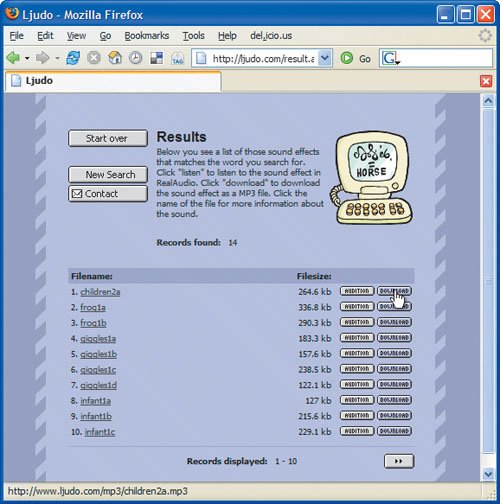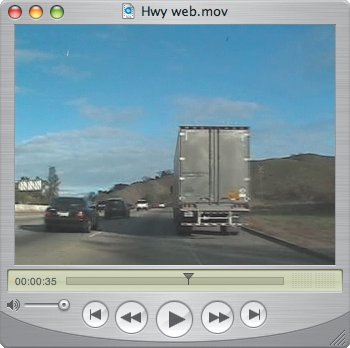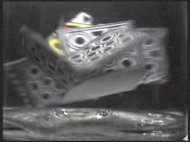Adding and Mixing Sound
| As we've mentioned before, sound is as important to a video as visuals. Music, sound effects, and narration can change the emotional content of your video. It can create the perfect mood, add the right finishing touch, or mix intensity with humor to create a unique perspective. Adding audio files to your project is easy in both iMovie and Movie Maker. You can simply drag your audio files to the bin or in iMovie, use File > Import, or in Movie Maker, File > Import into Collection. Then make sure to switch to the timeline view to work with audio tracks (Figure 5.36). After you add individual audio tracks, you'll need to mix them together to create a good, balanced sound (Figure 5.37). Figure 5.36. The Show Timeline button in Movie Maker does just thatshows the timeline.
Figure 5.37. The clock button in iMovie will switch you to timeline view.
Creating Voice-OversSometimes the visuals you choose for your vlog can stand alone. But in some videos, the visuals are not enough. They may need a narration, or voice-over, to add editorial comment at specific moments (Figure 5.38). Figure 5.38. In Pouringdown's "Theory: Practice," http://pouringdown.blogspot.com/2006/02/theory-practice.html, a voice-over provides insight into the creator's thoughts about his process for creating videoblogs.
Note When adding a voice-over to your vlog, a good rule of thumb is to add extra information with the voice-over instead of simply describing what's happening. Most editing programs, including iMovie (Figure 5.39) and Movie Maker (Figure 5.40) have options for recording voice-overs directly into your sequence. This allows you to record your voice-over while watching the video, rather than having to sync your audio to your video. Figure 5.39. Because Macs have a built-in mic, you can add a voice-over in iMovie by simply pressing the Record button and talking.
Figure 5.40. You can access the voice-over tool in Windows Movie Maker by clicking the Narrate Timeline button.
Macs and some Windows laptop have built-in microphones. Desktop PCs tend not to have built-in mics but makers often include external mics with their machines. If you have a PC without any mic, or if you have a Mac but you don't like the sound from its built-in mic, consider buying a USB microphone. Logitech (www.logitech.com), for example, offers a desktop microphone for less than $30. Adding MusicWorking with music is another magical element of the editing process. Add the right music to a string of dull images and suddenly they're full of life. Music can add depth to a scene by underscoring the emotion you've captured in your visuals. It can also add complexity by adding a different mood than what the visuals suggest. You can make music the main event in your video by selecting it first and then editing the visual images to create your own music video (Figure 5.41). Figure 5.41. In "Highway of Life," http://dianasallin.blogspot.com/2006/02/highway-of-life.html, Diana created a music video by cutting a collage of traveling-down-the-highway images to illustrate her own song.
If you're a songwriter or simply like putting tracks together using a music-creation program, you can use your own musicand only your own musichowever you like (see Chapter 2, "Using Other Material"). Don't forget that Creative Commons has links to free music resources at http://creativecommons.org/audio. Adding Sound EffectsSound effects can be a fun element to mix into a soundtrack. But like visual effects, they can be overused and make your video project sound like a Saturday morning cartoon (Figure 5.42). Figure 5.42. iMovie provides a variety of sound effects that you can add to your videos. Simply drag and drop the sound effect from the list to where you want it in your Timeline.
There are plenty of places on the web to find and purchase royalty-free sound effects. However, licenses for the use of these files might not always extend to cover their use in your videos on the web. To be free and clear, we recommend using sites like Ljudo, at http://ljudo.com, where all the sound effects are Creative Commons licensed (Figure 5.43). Figure 5.43. You can search Ljudo for Creative Commons licensed sound effects. These are the results of a search for "laugh." Many videobloggers like to mix sound effects into a soundtrack with a light hand, adding audio flavor so carefully that the audience isn't immediately aware that the soundtrack includes one or more sound effects. Figure 5.44 offers one example. Figure 5.44. In Scratch Video's "Collection: QuantumMatter" at www.scratchvideo.tv/scratch/2005/10/collection_quan_1.html, the sound effects are so subtle a viewer can hardly tell what might be effects and what might be part of the video's original sound.
Mixing Audio and Smoothing CutsNow that you've added more sound to your video, it's important to make sure that your soundtrack transitions smoothly from one cut to the next, in the same way that your video does. It may be as simple as fading the audio in at the beginning or out at the end. Other times it can be more complex. The story you are telling helps determine your approach to editing the soundtrack. If your soundtrack includes a conversation, for example, you can smooth an audio transition by making a cut at a natural pause in the conversation. This keeps the audio cut from seeming too abrupt and allows the visuals to keep flowing. Sometimes cutting from video to a title can sound abrupt and jarring because the video had ambient sound, or room tone, and the title was an audio vacuum that had no sound at all. This type of audio jump can be smoothed over by adding a piece of room tone to the title so that the soundtrack is continuous. It's a good idea to record a few seconds of room tone in each location where you shoot video. If you forget, don't panic. After a shoot, there's nearly always a few seconds of footage in which no one speaks that you can use as audio filler if needed. Pay attention to the visuals in your video and how they interact with any music you've added. For example, be sure to lower your music tracks when people start talking so viewers can actually hear your subject speak. It's fine to keep music underneath an interview, just make sure the sound levels are balanced. The smoother the audio sounds, the smoother the video will seem to your audience. |
EAN: 2147483647
Pages: 81







